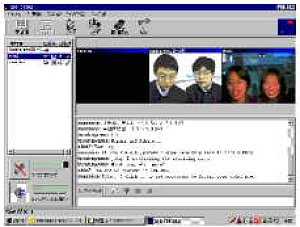 5. Theme
5. Theme Conference to introduce results from the 100-School Networking Project (Phase
II)
Theme meeting
(1) Creating and running a virtual classroom
(2) Use of a virtual classroom in lessons
(3) Education about international understanding and information
(4) Teaching foreign languages (English, Japanese, and Korean)
(5) Communicating with schools in the areas where time differences do not pose a problem
(1) Australia: two high schools
(2) United States: two high schools and two colleges
(3) Korea: two high schools
(4) Canada: one high school
(5) Japan: eight high schools
 5. Theme
5. Theme (1) Multiculturalism: Australian room
(2) People's lives a hundred years ago: American room
(3) Pre-study for a school trip: Korean room
(4) Our environment: Canadian room
(5) Communication using CU-SeeMe: Japanese room
Benefits
| (1) | Creating a network for teachers Teachers were able to establish a network, overcoming problems including far-flung locations, school types, student ages, lesson styles, and environments for Internet use. |
| (2) | Increased international understanding and information-related
knowledge A composition written by a child who immigrated to Australia A composition written by students from an international school in Canada with complicated cultural and family backgrounds National pride of Korean students |
| (3) | Collaborating with other teachers and colleges Collaborating with the domestic science class on food and gender differences (Akatsukayama High School) Collaborating with the social studies class in a study conducted with Korean students (Tezukayama High School) Learning about the real world by communicating with students from a community college (Seiryo Commercial High School) Collaborating with a social studies class on mental health (Kaizukita High School) |
| (4) | Exchanging substantive letters in English "Developing your mind," "the Japanese economy," and "an Information-oriented society" (Kaizukita High School) Manuscript for an English speech contest (Tezukayama High School) |
| (5) | Conducting school events to increase their significance for
students (Tezukayama High School) A teleconference held at a foreign language camp Sending information overseas about an English speech contest A school trip to Korea and a joint study between Japan and Korea, using CU-SeeMe |
Problems
| (1) | Lack of exchange between teachers, rules concerning the volume
of e-mail to be written in English, and lack of clear grasp of the theme |
| (2) | Suitability of the coordinators |
| (3) | Problems concerning copyrights |
| (4) | Regulations protecting personal information and problems concerning the
publication of personal information on home pages |
| (5) | Differences in vacation and school term dates |
| (6) | Lack of communication between classrooms |
| (7) | Lack of a system to deal with problems—he server crashed during one
communication session. (Kobe Commercial High School) |
| (8) | Delays in starting the project |
(1) Collecting model sentences for writing letters in English
(2) Holding regular meetings using CU-SeeMe
(3) Creating an Internet high school
| (1) | Participants: seventy-six tenth graders from two classes
of *the International course* Subject: English |
| (2) | Flow of activity A survey of student awareness Learning about information basics and mastering e-mail Meeting students from other schools (using a teleconferencing system and CU-SeeMe) Exchanging substantive letters Experiencing the fun of the Internet, by viewing home pages Regular meetings and lessons |
Activities thus far
| April: | We surveyed student awareness of international communications
and the Internet. |
| July: | Students from Hawaii and Korea participated in our foreign
language camp. |
| August: | A PCL room was established. (Fifty computers with Internet
access were installed.) |
| September: | Students from our computer club demonstrated a network game
in the PCL room at the school festival. |
| October: | In the PCL room, tenth graders in *the International course*
learned how to use a computer and how to send e-mail. To prepare for the school trip, students corresponded with students from two high schools in Korea. |
| December: | Students in Japan and Korea jointly studied "the history
of *Mt. Touki*" (using an ISDN teleconferencing system). Five teachers from schools participating in the project visited our school and took part in this study. We sent video mail of students from *the International course* giving speeches for their English speech contest to schools in Korea and Australia. We tested CU-SeeMe several times with schools in Hawaii and Korea. Students of the computer club managed and maintained the club's web server. |
| January: | Using CU-SeeMe, we began holding regular meetings with Korean
students. |
 Conference to introduce results from the 100-School Networking Project (Phase II)
Conference to introduce results from the 100-School Networking Project (Phase II)